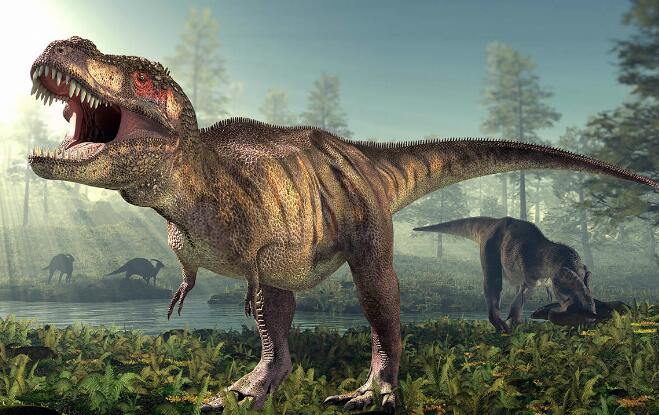Was Tyrannosaurus rex as smart as a baboon? Scientists don’t like to compare intelligence between species (everyone has their own talents, after all), but a controversial new study suggests some dino brains were as densely packed with neurons as those of modern primates. If so, that would mean they were very smart—more than researchers previously thought—and could have achieved feats only humans and other very intelligent animals have, such as using tools.
The findings, reported last week in the Journal of Comparative Neurology, are making waves among paleontologists on social media and beyond. Some are applauding the paper as a good first step toward better understanding dinosaur smarts, whereas others argue the neuron estimates are flawed, undercutting the study’s conclusions.
Measuring dinosaur intelligence has never been easy. Historically, researchers have used something called the encephalization quotient (EQ), which measures an animal’s relative brain size, related to its body size. A T. rex, for example, had an EQ of about 2.4, compared with 3.1 for a German shepherd dog and 7.8 for a human—leading some to assume it was at least somewhat smart.
EQ is hardly foolproof, however. In many animals, body size evolves independently from brain size, says Ashley Morhardt, a paleoneurologist at Washington University School of Medicine in St. Louis who wasn’t involved in the study. “EQ is a fraught metric, especially when studying extinct species.”
Looking for a more trustworthy alternative, Suzana Herculano-Houzel, a neuroanatomist at Vanderbilt University, turned to a different measure: the density of neurons in the cortex, the wrinkly outer brain area critical to most intelligence-related tasks. She had previously estimated the number of neurons in many animal species, including humans, by making “brain soup”—dissolving brains in a detergent solution—and counting the neurons in different parts of the brain.
That’s not possible with dinosaur brains. But Herculano-Houzel recognized an opportunity last year when researchers published a large database showing that, compared with reptiles, birds (and mammals) have much higher densities of neurons in their cortexes. Modern birds are related to extinct theropods—a group of carnivorous dinosaurs that included T. rex—so Herculano-Houzel wanted to see whether she could use some comparative anatomy tricks to estimate the neuronal density of dinos.
Based on estimated brain masses obtained with CT scans of dinosaur skulls (see 3D model, below), and a large database of brain masses of birds and reptiles from last year, she developed an equation correlating an animal’s brain mass with the approximate number of neurons in the cerebrum, which includes the cortex. She found that theropod brains roughly follow the same rules as warm-blooded modern birds, such as ostriches, whereas the brains of sauropod dinosaurs, such as Brachiosaurus, are more similar to those in modern cold-blooded reptiles. Ornithischians, another dinosaur group that includes Triceratops, as well as some pterosaurs followed one or the other brain equation, depending on the species. Then, she ran the numbers and came up with a series of estimated neuronal densities for a variety of dinosaur species.
“It’s awesome, quite frankly, to be able to get these numbers for these amazing creatures that don’t exist anymore and to be able to add something to the puzzle of what were their lives like … before the asteroid,” Herculano-Houzel says.
Alioramus, a 6-meter-long theropod that lived about 70 million years ago in what is now Mongolia, had just over 1 billion neurons in its cortex, similar to capuchin monkeys. And T. rex, with its brain weighing one-third of 1 kilogram, had an estimated 3.3 billion cortical neurons—a higher density than baboons, Herculano-Houzel reports.
“I have a whole newfound respect for T. rex,” she says. “Something that big with those teeth that had the cognitive capacity, numberwise, of a baboon … that is legit scary.”
Experts say the paper presents a compelling premise. “Until now, we didn’t have any idea of the possible number of neurons dinosaurs could have,” says Fabien Knoll, a paleontologist with the Aragonese Foundation for Research and Development at Dinópolis, a paleontological museum in Teruel, Spain.
“It’s really refreshing to actually have a neurologist looking at paleontological data,” adds Stig Walsh, senior curator of vertebrate paleobiology at the National Museums Scotland, also not involved with the work. Still, he says, it’s “an awful lot of conclusions or suggestions based on what’s essentially one single extrapolation.
Amy Balanoff, an evolutionary biologist at Johns Hopkins University, is also mixed on the findings. “T. rex was probably a pretty agile, fairly intelligent predator, [so] it’s nice to have these types of data to support that,” she says. However, much of the data behind Herculano-Houzel’s brain mass estimates are several years out of date, she notes. Balanoff and colleagues published a large data set in 2020 with several brain mass estimates for birds and dinosaurs, but the data Herculano-Houzel used come from data sets published in 2013 or earlier. The study likely overestimates the masses of dinosaur brains, she and others say.
Combining previous research with the new neuron-density estimates, Herculano-Houzel also predicted that T. rex would have taken 4 to 5 years to reach sexual maturity, and could have lived a maximum of 49 years—also similar to baboons. If so, that could mean some dinosaurs may have used tools—similar perhaps to crows using sticks to fish out insects—and passed on knowledge from generation to generation, just like some modern primates.
Yet such extraordinary claims require a lot more evidence to back them up, Morhardt says. “We’d need more data from the fossil record.” Tool use in particular “is far-fetched,” Knoll agrees.
Even if the neuronal-density estimates get sorted out, though, Morhardt says they won’t tell the whole story of dinosaur intelligence. There are other aspects of brain physiology, such as the way neurons connect, that play a role. But she’s thrilled that this study may open the door to a better understanding of dinosaurs’ mental acuity. “Studies like this one,” she says, “will only continue to hone our understanding of what was and wasn’t possible for amazing creatures such as T. rex.”
